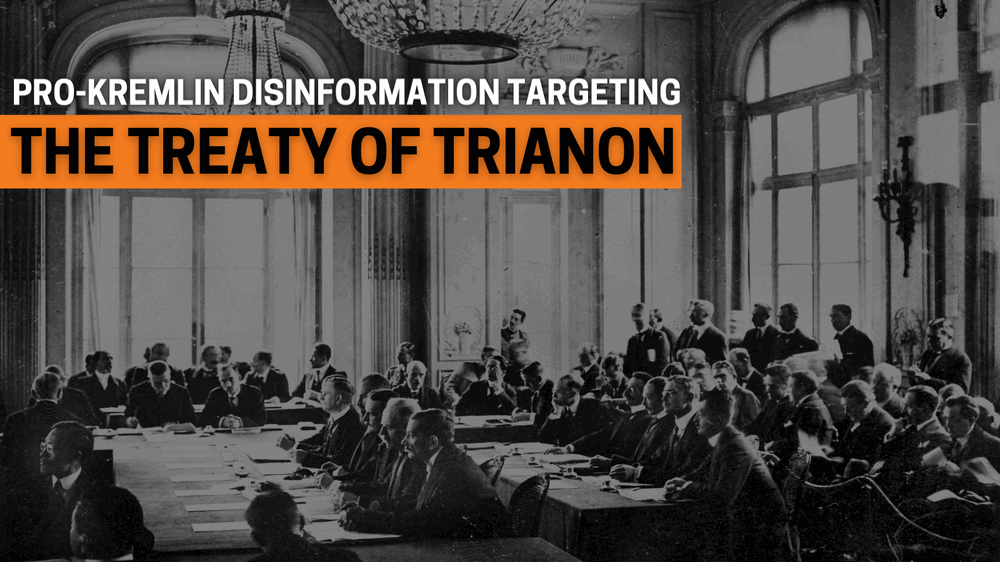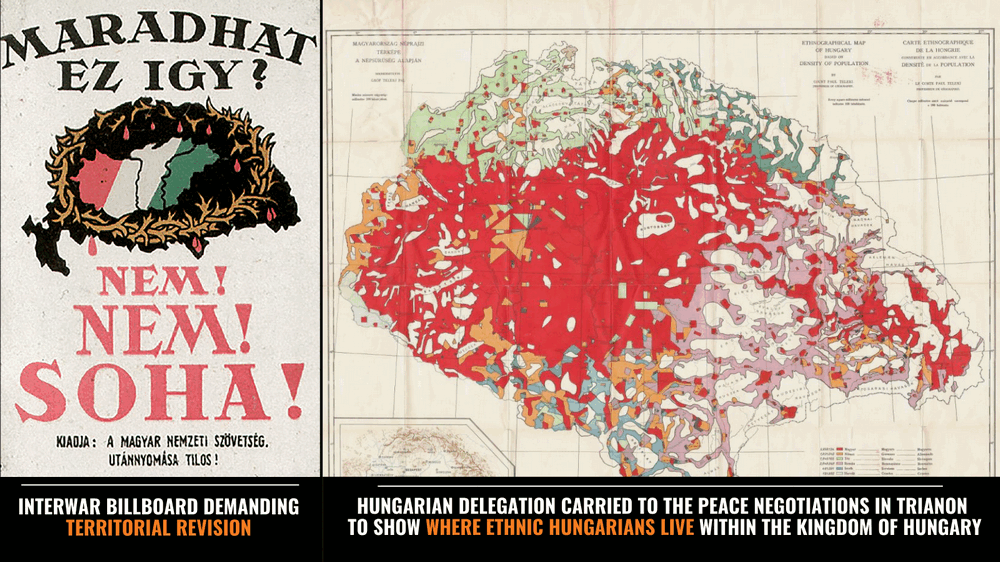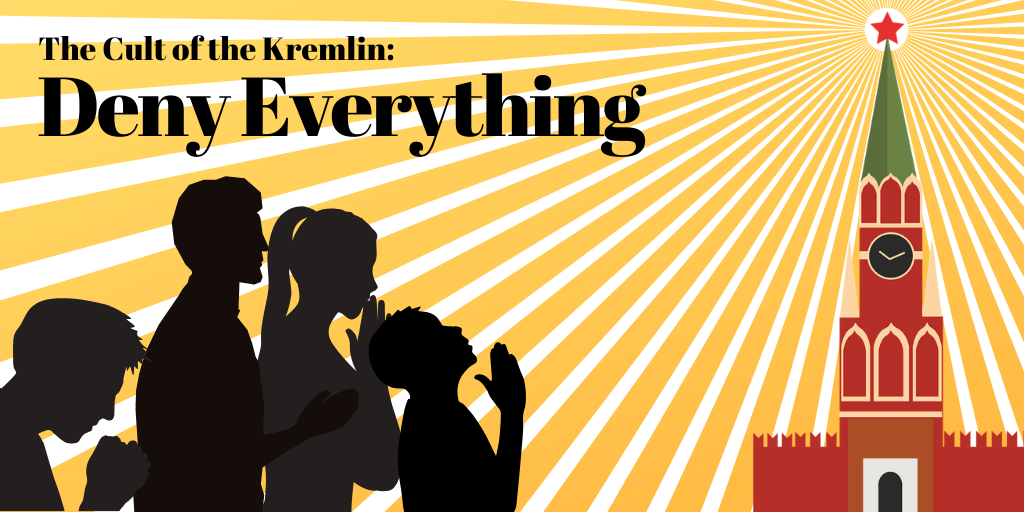The most effective disinformation efforts are tailored to the specific circumstances of particular countries and regions, exploiting existing societal tensions or bilateral disputes. In Hungary, the living memory of loss and defeat encapsulated by the Treaty of Trianon also offers an easy attack angle on Ukraine. Pro-Kremlin portals in Hungary like to cover events in Ukraine in a manner suggesting that Hungary might recover its lost territories there in the near future – even though Budapest is not making any territorial claims on its neighbours.
‘The Trauma of Trianon’
Hungary, which formed part of the Habsburg Empire before the First World War and was, together with Austria and Germany, among the losers of the war, saw two-thirds of its territory and almost as much of its population go to newly formed states in its neighborhood. Signed in 1920, the Treaty of Trianon – a companion to the better-known Treaty of Versailles – enshrined these losses; it continues to serve as a reminder of defeat to this day, providing pro-Kremlin media with opportunities to misuse it for political purposes.
The ‘Trauma of Trianon’, as many refer to it, is still part of Hungarians’ collective memory, not only because discussing it was prohibited during the Communist era but also because many Hungarian families still have relatives living in neighboring countries. A recent Pew poll found that 67 percent of Hungarians believe that parts of neighboring countries ‘really belong to us’. A representative Hungarian poll revealed that 94 percent of respondents believed Trianon was unfair to Hungary and one-third said (wrongly) that the treaty would expire after a hundred years.
Mainstream Hungarian political forces generally refrain from using the memory of Trianon to provoke neighbors and play on people’s feelings. However, extremist political groups have been seeking to capitalize on the memory of the treaty, calling for the ‘reclamation’ of lost territories or the repeal of the 1921 law ratifying the Treaty of Trianon (even though Hungary’s borders are outlined by the 1947 Treaty of Paris).
Adding Fuel to the Fire
In the Kremlin’s efforts to stir up trouble, the first key message is that Hungary still has an opportunity to lay its hands on Transcarpathia – a formerly Hungarian region in western Ukraine – thereby constructing a parallel to Russia’s actions in eastern Ukraine and Crimea.
One of the first such occasions was an attempt
to sell Vladimir Zhirinovsky’s plans presented in 2014 as a Euro-Atlantic initiative to divide Ukraine, which would have allegedly granted Transcarpathia to Hungary. Another article, cataloged in the EUvsDisinfo database, called on Kyiv to give up some of its territories because Ukraine allegedly ‘did not register its borders with the UN,’ meaning it does not have official state borders. The leadership of the country should, according to the article, give up the territories Ukraine gained when it was part of the USSR, including Transcarpathia, where most of the Hungarian minority lives.
Ukraine was also supposedly ready to give parts of Transcarpathia to Hungary, while Transcarpathia can join the EU without Ukraine. Similar narratives are also present when the claims are not focusing on Ukraine: a Hungarian Facebook page that regularly shares pro-Kremlin content from RT and Sputnik rejoiced when President Putin said that if the issue of Kaliningrad was discussed, the question of Hungary and Romania would have to be revisited as well:
If someone is willing to reconsider the results of World War II, let us discuss this. But then we will have to discuss not only Kaliningrad, but also the eastern lands of Germany, the city of Lvov, a former part of Poland, and so on, and so forth. There are also Hungary and Romania on the list. If someone wants to open this Pandora’s box and deal with it, all right, go for it then.
On other occasions, narratives spread by pro-Kremlin media implicitly suggest to their Hungarian readers that there is a chance for Transcarpathia to return to Hungary. For instance, there are articles discussing Ukraine being ripped apart into eastern and western states, or that the Poles are ready to take
Lviv by introducing their own language and culture to the city. These claims, in the Hungarian context, represent an effort to raise readers’ expectations.
‘Correcting a Historical Wrong’ in Ukraine
The second main message about Ukraine, and more specifically Crimea, is that Russia is only correcting a historical wrong that very much resembles what was committed against Hungary in 1920. In some of these cases, pro-Kremlin portals repeat popular Hungarian narratives regarding Trianon, but solely in the context of Crimea, without mentioning the post-WWI treaties. Crimeans, they say, simply fought to correct a ‘historical wrong’ something that often comes up in the Trianon-related rhetoric of the Hungarian far-right. At the same time, there are articles explicitly linking Crimea and Trianon: pro-Kremlin portal Orosz Hírek explained to its Hungarian readers that ‘Ukrainian statesman Nikita Khrushchev’ gave the ‘territory [of Crimea]’ to the Ukrainian SSR, so they ‘moved people against their wishes just like they did with the Hungarian ethnic group in Trianon.’
The third message concerns false allegations that Ukraine is fighting ethnic Hungarians just like it fights against ethnic Russians. Pro-Kremlin media seek to generate tensions between Ukrainians and Hungarians in Transcarpathia in the hope of provoking further bilateral tensions between the two sides. One article, for instance, claimed that the ‘fascist military junta’ wants to incite civil war in Transcarpathia by sending the bloodthirsty ‘Galician Nazis’ there.
The same websites that make such claims and state – among other things – that ‘fascism conquered most of Ukraine’ are, curiously, very friendly to fascists when it comes to Trianon. One article on News Front Hungary
praises fascist Italian leader Benito Mussolini for supporting Hungary in the Italian Senate in 1928, as well as the Italian fascist magazine Gioventù Fascista for calling for justice for Hungary at the time.
Overall, pro-Kremlin disinformation in Hungary seeks to pull Hungarians’ sympathies to the Russian side in the case of the illegal annexation of Crimea, partly by drawing parallels between the ‘historical wrongs’ done to Hungary at Trianon and to ‘Russian Crimea.’ As a result, pro-Kremlin narratives aim to improve Hungarians’ sentiments on Moscow’s aggression and turn them against Ukraine.
Unsurprisingly, pro-Kremlin media claims have little grounding in reality. Hungary’s 2020 national security strategy clearly states that Hungary does not consider any country as an enemy, and it seeks to resolve disputes peacefully in line with the principles of the UN Charter and international legal norms. Moreover, the Hungarian government has consistently supported Ukraine’s territorial integrity and independence. It is true that Budapest and Kyiv have disagreed over the 2017 Ukrainian language law, which was also criticized by the Venice Commission (a Council of Europe advisory body on constitutional law), but there are no signs whatsoever that either side is about to use military means to resolve the issue. Regardless, any insinuation of a conflict brewing between Hungary and Ukraine, real or imagined, is set to be used as an opening for pro-Kremlin propaganda in the future.
Further reading:
- Ukraine and Hungary move to settle differences over national minority legislation
- Ukraine-Hungarian relations: a tale of mounting mutual mistrust
- Attack on Hungarian centre in Ukraine: three Poles charged with terrorism in German journalist-planned plot (2019)
- How Hungary became a weapon of Russian disinformation (2018)
- Tensions flare after Hungarian consul caught secretly issuing passports in western Ukraine (2018)
- "Hungary’s Jobbik Party shows itself to be Putinist, not Hungarian nationalist" (2018)
- Hungary has stabbed us in the back, says Ukrainian political scientist (2018)
- Separatism Transcarpathian style: is Hungary aiming to grab a part of Ukraine? (2017)
- Ukrainian-Hungarians that have died fighting for Ukraine’s freedom
- 100 years ago: the decline of the Austro-Hungarian Empire & birth of the West Ukrainian National Republic
- "Hungary openly helping Putin destabilize Ukraine" (2015)
- The struggle for Carpatho-Ukraine (1938-1939), or how WWII started for Ukrainians







